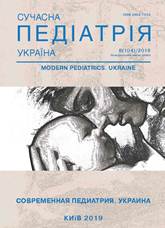Renoprotection in children with congenital anomalies of kidney and urinary tract
Keywords:
renoprotection, congenital anomalies of kidney and urinary tract, children, chronic kidney disease, enalaprilAbstract
Objective: to assess the effect of 5-year renoprotective therapy on slowing down the progression of chronic kidney disease (CKD) in children with congenital anomalies of kidney and urinary tract (CAKUT).Materials and methods. The study involved 69 patients with CAKUT and CKD of stages 1–3 (3a and 3b) aged 2 to 17 (8.3±0.5). The renoprotective therapy for CAKUT patients was prescribed taking into account and subject to control of the glomerular filtration rate (GFR), serum cystatin C, albumin excretion rate (AER), albumin/creatinine ratio (ACR), and serum potassium rate, in accordance with the proposed algorithm of using the antagonists of the renin-angiotensin-aldosterone system (RAAS) in CKD patients. Patients with CKD of stages 1–2 were prescribed monotherapy with enalapril at 0.2–0.4 mg/kg daily. Patients with CKD of stage 3 (3a and 3b) were prescribed monotherapy with enalapril or fosinopril at 0.1–0.2 mg/kg daily.
Results. 5-year experience of using renoprotection in children with CAKUT allowed slowing down CKD progression in 96.4% of patients with CKD stage 1, in 91.2% of patients with CKD stage 2 and in 71.4% of patients with CKD stage 3 (3a and 3b).
Conclusions. In CAKUT patients with CKD of stages 1–3 (3a and 3b), the anti_RAAS therapy has proven its renoprotective efficacy and safety.
The research was carried out in accordance with the principles of the Helsinki Declaration. The study protocol was approved by the Local Ethics Committee of an institution. Informed consent was obtained from the parents of the children (or their guardians) for the research.
References
Ivanov DD. (2018). Nephrology under the microscope. Individualization of renoprotection. Ukrainian medical journal. 1(5): 68–69.
Kushnirenko SV. (2015). CAKUT0syndrome and chronic kidney disease — the concept of nephrology approach. Kidney. 3: 37–41. https://doi.org/10.22141/2307-1257.0.3.13.2015.74928
Shvetsov M. (2009). Modern nephroprotective therapy: the possibilities of lisinopril. Vrach. 6: 36–39.
Shishkin AN, Kirilyuk DV. (2005). Endothelial dysfunction in patients with progressive renal disease. Nephrology (Saint-Petersburg). 9(2): 16–22.
ESPN/ERA-EDTA Registry 2016 // ESPN Registry http://www.espn.org.
Fox JA, Dudley AG, Bates C, Jr.Cannon GM. (2014). Cystatin C as a marker of early renal insufficiency in children with congenital neuropathic bladder. J. Urol. 191(5): 1602–1607. https://doi.org/10.1016/j.juro.2013.09.093; PMid:24679869.
Harambat JJ, van Stralen K, Kim J et al. (2012). Epidemiology of chronic kidney disease in children. Pediatric Nephrology. 27(3): 363–373. https://doi.org/10.1007/s00467-011-1939-1; PMid:21713524 PMCid:PMC3264851
Heerspink HJL, Kröpelin TF, Hoekman J et al. (2015). Drug-induced reduction in albuminuria is associated with subsequent renoprotection: a meta-analysis. J Am Soc Nephrol. 26(8): 2055–2064. https://doi.org/10.1681/ASN.2014070688; PMid:25421558 PMCid:PMC4520175.
https://www.kidney.org/professionals/KDOQI/gfr_calculatorPed
Kidney Disease: Improving Global Outcomes (KDIGO) СKD Work Group. KDIGO 2012. (2013). Clinical Practice Guideline for the Evaluation and Management of Chronic Kidney Disease. Kidney Inter Suppl. 3(1): 5–9. https://doi.org/10.1038/kisup.2012.73 ;PMCid:PMC4089625.
National Kidney Foundation. (2002). K/DOQI Clinical Practice Guidelines for Chronic Kidney Diseases: Evaluation, Classification and Stratification. Am. J. Kidney Dis. 39(1): 44–45.
Salvador CL, Tondel C, Rowe AD et al. (2019). Estimating glomerular filtration rate in children: evaluation of creatinineand cystatin C0based equations. Pediatric Nephrology. 34(2): 301–311. https://doi.org/10.1007/s00467-018-4067-3; PMid:30171354.
Xie X, Liu Y, Perkovic V et al. (2016). Renin-angiotensin system inhibitors and kidney and cardiovascular outcomes in patients with CKD: a Bayesian network meta0analysis of randomized clinical trials. Am J Kidney Dis. 67(5): 728–741. https://doi.org/10.1053/j.ajkd.2015.10.011; PMid:26597926.
Downloads
Issue
Section
License
The policy of the Journal “MODERN PEDIATRICS. UKRAINE” is compatible with the vast majority of funders' of open access and self-archiving policies. The journal provides immediate open access route being convinced that everyone – not only scientists - can benefit from research results, and publishes articles exclusively under open access distribution, with a Creative Commons Attribution-Noncommercial 4.0 international license (СС BY-NC).
Authors transfer the copyright to the Journal “MODERN PEDIATRICS. UKRAINE” when the manuscript is accepted for publication. Authors declare that this manuscript has not been published nor is under simultaneous consideration for publication elsewhere. After publication, the articles become freely available on-line to the public.
Readers have the right to use, distribute, and reproduce articles in any medium, provided the articles and the journal are properly cited.
The use of published materials for commercial purposes is strongly prohibited.

